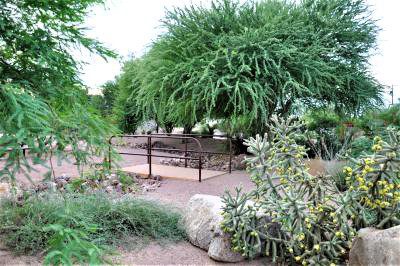Tucson’s Storm to Shade program creates a cooler city
November 13, 2024


AWWA Articles
Tucson’s Storm to Shade program creates a cooler city
Most folks don’t think of locations in Arizona’s desert region as cool and shady, but a City of Tucson program to capture and reuse stormwater runoff aims to change that.
The city launched its Storm to Shade (S2S) green stormwater infrastructure program in 2021 with funding from surcharges based on water usage. Since then, the program has completed eight green infrastructure projects on public property, with about 20 more in the works.
“S2S is a voluntary, non-regulatory driven program, and our mission is to capture stormwater runoff for use as the primary irrigation resource to green up the urban environment,” said Blue Baldwin, who manages the program. “We’re catching stormwater runoff and putting it into vegetated basins to grow shade and habitat throughout the city.”
In Tucson, stormwater comes on rare occasions but in large quantities, so it’s important to be able to capture it and put it to use. Minor tweaks to traditional “gray infrastructure,” such as curb cuts and flush curbs, allows stormwater from impervious surfaces to run into vegetated basins. Once there, the water infiltrates into the soil to irrigate native trees and vegetation.

“Tucson historically gets an average of 11-12 inches (of precipitation) a year, which is not much, but is a heck of a lot when it’s running down big streets and impermeable surfaces,” said Baldwin. “What we’re able to capture in our structures ends up being quite a bit, and it’s plenty to support native Sonoran Desert vegetation.”
Maximizing desert environment resiliency
Baldwin explained that the Sonoran Desert is the most biodiverse desert in the world, offering Tucson a large variety of leguminous trees, which have edible properties, cacti and succulents, which also have edible properties, and shrubs and grasses, many of which have edible and medicinal properties.
In addition to beautifying the city, green stormwater infrastructure offers important benefits for climate resiliency in the third-fastest warming city in the United States.
“For us specifically in Tucson, that is primarily the cooling benefits,” Baldwin said. “Growing the tree canopy to create shade. Also, vegetation acts like small evaporative cooling systems and cools our urban spaces as well. Secondary to cooling is habitat value and beautification, particularly in areas of the city that have been historically disinvested in.”
Baldwin says the shade created by the green infrastructure can lower temperatures by 10°-15° (Fahrenheit).
“If you can be in 100° instead of 115°, that’s a significant difference,” she said. “That’s all we’re talking about is that evaporative cooling effect and shade that vegetation provides.” Tucson has been building green infrastructure since the 1990s via grassroots efforts. The S2S program also maintains just shy of 800 green stormwater infrastructure features scattered throughout the city to ensure they are providing all the benefits green stormwater infrastructure offers.
Advertisement